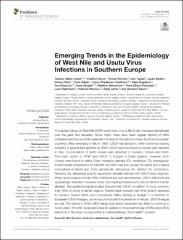Emerging Trends in the Epidemiology of West Nile and Usutu Virus Infections in Southern Europe

View/
Date
2019Author
Vivlibic-Cavlek, Tatjana
Savić, Vladimir
Petrović, Tamaš
Toplak, Ivan
Barbić, Ljubo
Petrić, Dušan
Tabain, Irena
Hrnjaković Cvjetković, Ivana
Bogdanić, Maja
Klobučar, Ana
Mrzljak, Anna
Stevanović, Vladimir
Dinjar-Kujundžić, Petra
Radmanić, Luka
Monaco, Federica
Listes, Eddy
Savini, Giovanni
Metadata
Show full item recordAbstract
The epidemiology of West Nile (WNV) and Usutu virus (USUV) has changed dramatically
over the past two decades. Since 1999, there have been regular reports of WNV
outbreaks and the virus has expanded its area of circulation in many Southern European
countries. After emerging in Italy in 1996, USUV has spread to other countries causing
mortality in several bird species. In 2009, USUV seroconversion in horses was reported
in Italy. Co-circulation of both viruses was detected in humans, horses and birds.
The main vector of WNV and USUV in Europe is Culex pipiens, however, both
viruses were found in native Culex mosquito species (Cx. modestus, Cx. perexiguus).
Experimental competence to transmit the WNV was also proven for native and invasive
mosquitoes of Aedes and Culex genera (Ae. albopictus, Ae. detritus, Cx. torrentium).
Recently, Ae. albopictus and Ae. japonicus naturally-infected with USUV were reported.
While neuroinvasive human WNV infections are well-documented, USUV infections are
sporadically detected. However, there is increasing evidence of a role of USUV in human
disease. Seroepidemiological studies showed that USUV circulation is more common
than WNV in some endemic regions. Recent data showed that WNV strains detected
in humans, horses, birds, and mosquitoes mainly belong to lineage 2. In addition to
European USUV lineages, some reports indicate the presence of African USUV lineages
as well. The trends in WNV/USUV range and vector expansion are likely to continue in
future years. Thismini-review provides an update on the epidemiology of WNV and USUV
infections in Southern Europe within a multidisciplinary “One Health” context.
